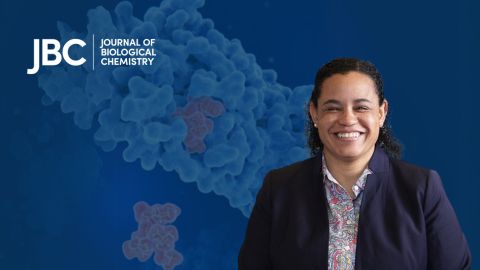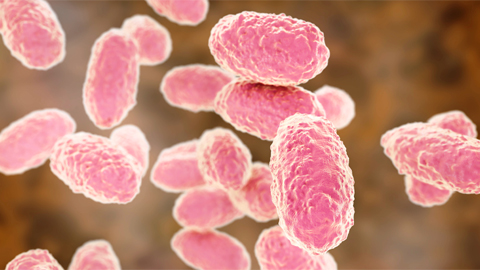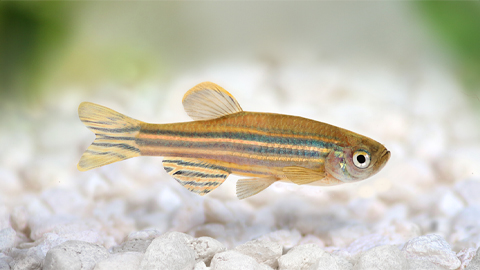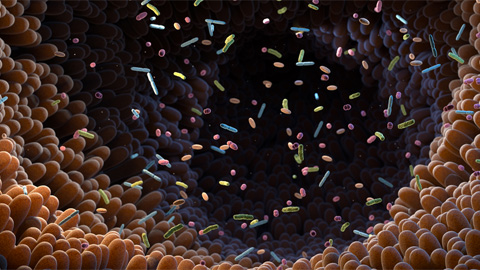From the journals: JBC
M binds PS in RSV infection. Screening for drugs to treat heart disease. Protein ‘feet’ help DNA form loops. Read about papers on these topics recently published in the Journal of Biological Chemistry.
M binds PS in RSV infection
Respiratory syncytial virus, or RSV, primarily affects infants and the elderly. Despite recently developed vaccines for adults and a monoclonal antibody treatment for infants, the burden of RSV infection remains a major unmet target for widespread and affordable antiviral therapy.

Similar to other viruses, RSV loads genomic RNA into filamentous particles and inserts them into the host cell membrane, and when the membrane is recycled by the cell the viral RNA and proteins are released. Viral matrix, or M, protein dimers are crucial for filament assembly, as are other minimal components known as P and FCT, but scientists don’t yet know how these dimers or other viral glycoproteins specifically interact with the host membrane.
In a recent article in the Journal of Biological Chemistry, Jitendriya Swain and colleagues at the Institute of Research in Infectiology of Montpellier and University Paris–Saclay describe that the interaction between viral M protein dimers and lipid rafts in the host cell membrane is mediated by the negatively charged phospholipid phosphatidylserine, or PS. Using liposome sedimentation assays, they demonstrate that M alone could promote clustering of PS lipids, while other negatively charged lipids, such as phosphoinositol phosphates and viral glycoproteins like FCT, were unnecessary for this binding. In fact, they found that FCT may actually block M binding to PS, leading to the hypothesis that M binding to PS occurs first, and FCT interaction with M likely occurs after this initial membrane-binding event.
These findings suggest that the RSV M protein dimers selectively bind PS lipids and induce PS clustering in the host membrane. As this clustering is also observed in other enveloped viruses that bud from the plasma membrane, it is possible that the M–PS interaction is a common feature of these viruses and could represent a druggable target to prevent viral infection.
Screening for drugs to treat heart disease
Heart disease is one of the leading causes of death globally. Cardiomyopathies — including those that lead to enlarged chambers of the heart, hypercontractility, hypocontractility or arrhythmias — can lead to progressive heart failure and even sudden cardiac death.
One of the primary causes of these diseases is a mutation of one of several proteins, including actin, myosin or the actin- and myosin-binding protein cMyBP-C that modulates heart muscle contraction and relaxation. Although several drugs recently have been developed to target myosin to promote improved cardiac function in a subset of cardiac disease patients, identifying small molecules that can affect the interaction of cMyBP-C with actin and/or myosin is an additional promising approach for the treatment of cardiomyopathy.
In their new study published in the Journal of Biological Chemistry, Thomas Bunch, Piyali Guhathakurta and colleagues at the Universities of Arizona and Minnesota, Minneapolis, used two complementary high-throughput screens to not only identify Food and Drug Administration-approved compounds that could bind directly to cMyBP-C but also identify those compounds that modulated cMyBP-C function. They identified two compounds that preferentially bound unphosphorylated cMyBP-C (erythromycin estolate and erlotinib), suggesting they are worthy of further study.
These results indicate that several drugs already approved for use in humans could affect heart muscle regulation, although further optimization may be necessary to achieve sufficient dosing efficacy. The screening assays developed by the team could also be used to identify specific compounds that target cMyBP-C from a broader library.
Protein ‘feet’ help DNA form loops
The three-dimensional spatiotemporal organization of DNA into open and closed chromatin and condensed chromosomes is paramount in regulating DNA replication and repair and gene expression. The structural maintenance of chromosomes is mediated in part by the SMC protein family, including the cohesin protein complex and the cohesin-loading factor NIPBL.
One model of 3D genome organization involves the cohesin–NIPBL complex capturing DNA and extruding it in loops, but technical challenges in studying these dynamic complexes have made it hard to know how protein conformational changes mechanistically facilitate DNA looping.
In a recent paper in the Journal of Biological Chemistry, Parminder Kaur and colleagues at North Carolina State University describe how the cohesion–NIPBL complex maneuvers DNA using small protein protrusions. Their high-speed atomic force microscopy imaging in liquids shows that short protruding so-called “feet” from NIPBL and the cohesin complex subunit SA1 help facilitate loading of the cohesin-NIPBL complex onto DNA and DNA loop initiation independent of ATP hydrolysis.
These results show the unique power of HS-AFM in studying dynamic multi-subunit complexes, and specifically shed light on the mechanism, including distinct forward and reverse steps, by which individual subunits of the cohesion–NIPBL complex mediate DNA loop extrusion. Further investigation of this complex could solidify the roles of various protein subunits and domains in this process.
Enjoy reading ASBMB Today?
Become a member to receive the print edition four times a year and the digital edition monthly.
Learn moreGet the latest from ASBMB Today
Enter your email address, and we’ll send you a weekly email with recent articles, interviews and more.
Latest in Science
Science highlights or most popular articles

Meet Donita Brady
Donita Brady is an associate professor of cancer biology and an associate editor of the Journal of Biological Chemistry, who studies metalloallostery in cancer.

Glyco get-together exploring health and disease
Meet the co-chairs of the 2025 ASBMB meeting on O-GlcNAcylation to be held July 10–13, 2025, in Durham, North Carolina. Learn about the latest in the field and meet families affected by diseases associated with this pathway.

Targeting toxins to treat whooping cough
Scientists find that liver protein inhibits of pertussis toxin, offering a potential new treatment for bacterial respiratory disease. Read more about this recent study from the Journal of Biological Chemistry.

Elusive zebrafish enzyme in lipid secretion
Scientists discover that triacylglycerol synthesis enzyme drives lipoproteins secretion rather than lipid droplet storage. Read more about this recent study from the Journal of Biological Chemistry.

Scientists identify pan-cancer biomarkers
Researchers analyze protein and RNA data across 13 cancer types to find similarities that could improve cancer staging, prognosis and treatment strategies. Read about this recent article published in Molecular & Cellular Proteomics.

New mass spectrometry tool accurately identifies bacteria
Scientists develop a software tool to categorize microbe species and antibiotic resistance markers to aid clinical and environmental research. Read about this recent article published in Molecular & Cellular Proteomics.

